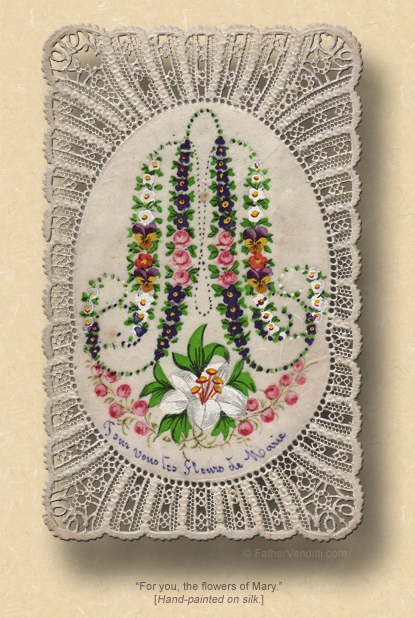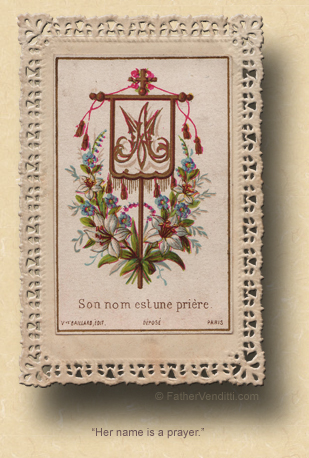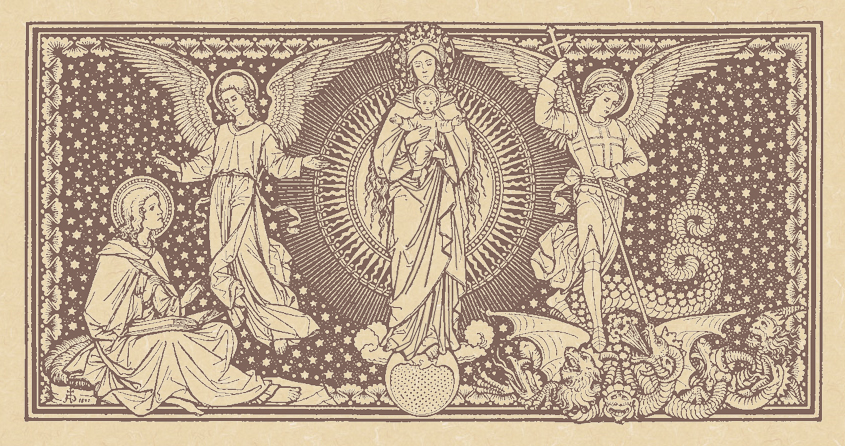All I Ask Is a Tall Ship and a Star to Steer Her By.
The Twenty-Fourth Monday of Ordinary Time; or, the Memorial of the Most Holy Name of Mary.
Lessons from the secondary feria, according to the ordinary form of the Roman Rite:
• I Corinthians 11: 17-26, 33.
• Psalm 40: 7-10, 17.
• Luke 7: 1-10.
|
…or, from the proper:
• Galatians 4: 4-7 (or Ephesians 1: 3-6).
• [Responsorial] Luke 1: 46-55.
• Luke 1: 39-47.
…or, any lessons from the common of the Blessed Virgin Mary.
|
The Third Class Feast of the Most Holy Name of Mary.
First & third lessons from the proper, Gradual from the common "Salve sancta…" of the Blessed Virgin Mary, according to the extraordinary form of the Roman Rite:
• Ecclesiasticus 24: 23-31.
• [Gradual] Benedicta et venerábilis es…*
• Luke 1: 26-38.
The Otdanije (Leave-Taking) of the Feast of the Birth of the Theotokos.**
Lessons from the pentecostarion, according to the Ruthenian recension of the Byzantine Rite:
• Ephesians 4: 25-32.
• Mark 10: 46-52.***
FatherVenditti.com
|
10:05 AM 9/12/2016 —
I must go down to the seas again, to the lonely sea and the sky,
And all I ask is a tall ship and a star to steer her by;
And the wheel’s kick and the wind’s song and the white sail’s shaking,
And a grey mist on the sea’s face, and a grey dawn breaking.
I must go down to the seas again, for the call of the running tide
Is a wild call and a clear call that may not be denied;
And all I ask is a windy day with the white clouds flying,
And the flung spray and the blown spume, and the sea-gulls crying.
I must go down to the seas again, to the vagrant gypsy life,
To the gull’s way and the whale’s way where the wind’s like a whetted knife;
And all I ask is a merry yarn from a laughing fellow-rover,
And quiet sleep and a sweet dream when the long trick’s over.
 That’s a poem called "Sea-Fever" by John Masefield, which first appeared in his collection Salt-Water Poems and Ballads, published in 1916 and, obviously, I read it to you for a reason as it relates—at least in my twisted mind—to today’s memorial. That’s a poem called "Sea-Fever" by John Masefield, which first appeared in his collection Salt-Water Poems and Ballads, published in 1916 and, obviously, I read it to you for a reason as it relates—at least in my twisted mind—to today’s memorial.
The Third Class Feast of the Holy Name of Mary was created by Pope Innocent XI to commemorate the victory of Catholic forces in Vienna over the Turkish tyrant who had long oppressed the Christians of Eastern Europe.† Even today the Turks are very sensitive to such issues, as evidenced by their anger at Pope Francis calling attention to the genocide they perpetrated against the Armenians prior to the First World War. Given that time-conditioned history, one might legitimately wonder how the feast survived the wrath of the post-conciliar reformers, given that these historical events don't “speak to us today.”
But God works in mysterious ways, and the feast survives not so much because we're attached to the military history of the Papal States, but because the Church, over time, learned to internalize the veneration for the Mother God to which Pope Innocent attributed the victory. But, to understand this, we need to liberate ourselves from a purely elementary and devotional appreciation for the Most Holy Name of Mary.
We don't often think about it, especially if we're handicapped by knowing only one language, but the name of Mary means “star of the ocean” or “star of the sea.” Mare, in Latin, means “ocean” or “sea”; the invocation in the Litany of the Blessed Virgin is not something that someone just made up: the name “Mary” actually means Stella Maris or “Star of the Sea,” referring to the star by which a sailor will navigate and find his way when there are no landmarks to guide him.
And “Star of the Sea” is a most fitting name for the Virgin Mother of God, Who can well be compared to a star; for, just as a star beams forth its rays without being diminished in any way, so Mary gave birth to a Son without any loss of Her virginity. She is that noble Star risen from Jacob and raised by God above the great and wide sea of this passing world, and shines with virtue to enlighten us with Her own bright example. And we, who find ourselves tossed to and fro on the ocean of this valley of tears, trying desperately to navigate the murky waters of worry and worldly concerns, often find ourselves without any landmarks to guide us.
Oh, the landmarks are there: we have the Holy Gospel, we have the Tradition of the Fathers, we have the example of the saints and the teachings of Holy Mother Church; shining out across the ocean of life like lighthouses, guiding us through shallow waters and around the reefs, they give us the Truths of the Faith, but they fall short sometimes in soothing our troubled spirits. That's a failing on our part, not the Church's.
But the God Who made us knows us better than we know ourselves, which is why He arranged things the way He did:
In the sixth month, the angel Gabriel was sent from God in a town of Galilee called Nazareth, to a virgin betrothed to a man named Joseph, of the house of David, and the virgin's name was Mary (Luke 1: 26-27 NABRE).
The “Star of the Sea,” a Star to steer by.

 * The Gradual is non-Scriptural: "Blessed and venerable art Thou, O Virgin Mary: Who without blemish to Thy maidenhood, wert found to be the Mother of the Saviour. O Virgin, Mother of God, He Whom the whole world cannot contain, enclosed Himself in Thy womb and became Man." * The Gradual is non-Scriptural: "Blessed and venerable art Thou, O Virgin Mary: Who without blemish to Thy maidenhood, wert found to be the Mother of the Saviour. O Virgin, Mother of God, He Whom the whole world cannot contain, enclosed Himself in Thy womb and became Man."
** In the Byzantine Tradition, major feast days are marked by prefestive and postfestive periods. While there is no corresponding tradition in the West regarding prefestive days, the postfestive period is concomitant with the concept of an octave in the Latin Church, though it's duration is not necessarily eight days depending on the importance of the feast. The last day of the postfestive period is called the "Leave-Taking," Otdanije in Slavonic, actually a verb meaning "to return." The liturgy on the day of Otdanije mirrors that of the feast with minor variations; in this case, the lessons are of the feria, not of the feast.
The Feast of the Martyr Autonomous (his name, not meant to indicate that he is unknown), ordinarily observed on this day, was transfered to yesterday's liturgy because of the Leave-Taking. Cf. the footnote to yesterday's homily for a brief treament of his life and significance.
*** The four Gospels are all read in their entirety in the Byzantine Churches, and the reading of each begins with a great feast. The Gospel of St. John begins with the Feast of Feasts, Pascha, and is read until Pentecost. The Gospel of St. Matthew begins with Pentecost, and is read until the Feast of the Holy Cross, after which the Gospel of St. Luke is read all the way through until the Great Fast; but, because the Divine Liturgy is offered only on Saturday and Sunday in the Great Fast, the left-over passages are read in the last six weeks of the Matthean and Lucan cycles. This is why we begin the reading of Luke’s Gospel on the Sunday after the Holy Cross no matter where we are in the cycle of "Sundays after Pentecost." The Epistles, on the other hand, are read continuously without any adjustment, creating a discrepancy between Epistle and Gospel. Since Pascha was so early this year, it will be necessary to repeat the Gospel of the 17th Sunday after Pentecost on the 18th Sunday; and, on Monday, September 19th, we will begin the Epistles for the 19th week after Pentecost and the Gospels for the 18th week, with a discrepancy of one week until Dec. 28th. In the Byzantine Churches, this is commonly called "the Lucan jump."
Following the Feast of the Holy Cross (Sept. 14th), the Greek Church actually labels these Sundays as “Sundays after the Holy Cross” and begins to number them accordingly, while the Ruthenian Church continues to number them as Sundays after Pentecost. The historical context of this custom was the Greek practice of marking the birthday of the Emperor Augustus on September 23rd, which they regarded as the first day of the Church year. It was not until the fall of the empire that the new year observance was moved to Sept. 1st.
† The feast of the Holy Name of Mary was already being observed in many places locally at the time of this great victory, which John Sobieski, king of Poland, gained against the Turks under the walls of Vienna. It gave Pope Innocent XI his long sought-after reason to make this feast obligatory throughout the whole Western Church as a yearly act of thanksgiving for the deliverance of Christian Europe.
|

